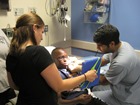iPads and Kids in the Emergency Room: Less Scary
 A trip to the emergency room is a scary experience when you’re a kid. First of all you’re hurt or sick. That’s bad enough, but then you come to a strange place where doctors and nurses in funny outfits start poking and prodding and asking confusing questions. It’s hard to blame a kid for kicking and screaming through all this, but that also makes it difficult for those doctors and nurses to do their jobs.
A trip to the emergency room is a scary experience when you’re a kid. First of all you’re hurt or sick. That’s bad enough, but then you come to a strange place where doctors and nurses in funny outfits start poking and prodding and asking confusing questions. It’s hard to blame a kid for kicking and screaming through all this, but that also makes it difficult for those doctors and nurses to do their jobs.
Unfortunately, often the only way to keep an upset, frightened child still enough to put in stitches or set a broken bone is to sedate them or use physical restraint. In the pediatric emergency department at the University of Chicago Medicine Comer Children’s Hospital, doctors and child life specialists are experimenting with a trendier way to keep kids calm in the ER and make their visit a little less scary: iPads.
Alisa McQueen, MD, assistant professor of pediatrics and director of the pediatric emergency medicine fellowship program, said kids often don’t understand what’s going on in the ER. “They can’t really understand that a procedure is temporary. They can’t understand that after we numb up a laceration it’s not going to hurt anymore to sew it,” she said. “It’s not their fault. They’re just too developmentally young and they can’t process it, so they end up kicking and screaming and thrashing and it’s no fun for anybody.”
Emergency department physicians and nurses have all kinds of tricks for distracting kids from scary procedures, from stuffed animals to games, music and videos, but success often depends on having the right toy at the right time. McQueen said that when Chelsea Cress, MS, CCLS, a child life specialist from the Child Life and Family Education department, started experimenting with using an iPad to entertain kids with videos, games and other interactive apps, they could tell that they were on to something. Besides letting kids play with Apple’s hottest gadget, they can load dozens of apps and videos on the device to prepare for any age level and any situation in the ER.
“If I was going to do a procedure with a kid before the iPad, I would have a portable DVD player, a light spinner, bubbles, all of these things that I would carry around in a bucket,” Cress said. “The procedure is happening whether I’m ready or not. If I didn’t have the right thing with me, by the time I went to get it, it might’ve been too late. Having the iPad is like having my box of tricks all in one.”
The child life specialists focus on children’s psychological and developmental needs in order to help them feel more comfortable during their hospital stay. They’ve been experimenting with using iPads throughout the hospital, taking advantage of its versatility beyond basic entertainment and web browsing. For instance, they use video chat to help families with children in the hospital communicate with relatives, and so new mothers can watch their babies in the neonatal intensive care unit. They also use educational games and videos to help children and their parents understand diseases or what’s happening while they’re in the hospital. Cress said some older kids even use them to take pictures of themselves getting stitches so they can show all their friends.
“It’s a device that we can really explore and utilize to the best of our abilities with children in hospital settings, something we’re trying to be at the forefront on in our department,” Cress said. “We’re always trying to think of new ideas beyond just the distraction during procedures, like how can we use it to help kids feel better about their experience and cope well with being here.”
McQueen, Cress and Alison Tothy, MD, medical director of pediatric emergency medicine, recently published a case study about their experience using iPads during pediatric procedures. McQueen said that besides lowering the stress levels in the emergency room, the iPads also help with the workload. Sedation requires extra nurses and physicians who could be treating other patients, and restraining an unruly child might mean two or three more people in the room. But if a child life specialist can distract a kid with a game of Angry Birds, those people can go do something else.
“It helps a lot with flow through the emergency department because each time you pull people into a room to get something done, other patients aren’t getting something done,” McQueen said. “That helps a lot because that’s the key thing we struggle against in the ER, families who are frustrated at waiting, especially with little kids.”
McQueen said anything to take the edge off the emergency room experience for families helps. “Going to the ER in general is a stressful experience no matter what, especially if your kid’s been hurt,” she said. “If we can alleviate that a little bit it makes the whole experience nicer.”
The potential uses for iPads in a children’s hospital are as limitless as the combinations of apps, games, music and videos you can put on them. Cress said she plans to keep pushing their limits at the University of Chicago.
“We know that kids can use their imaginations to take them to a place that most grownups can’t,” she said. “Using the iPad really helps them to cope with procedures better and forget about what’s happening at the hospital.”
Category: Healthcare Technology Trends
